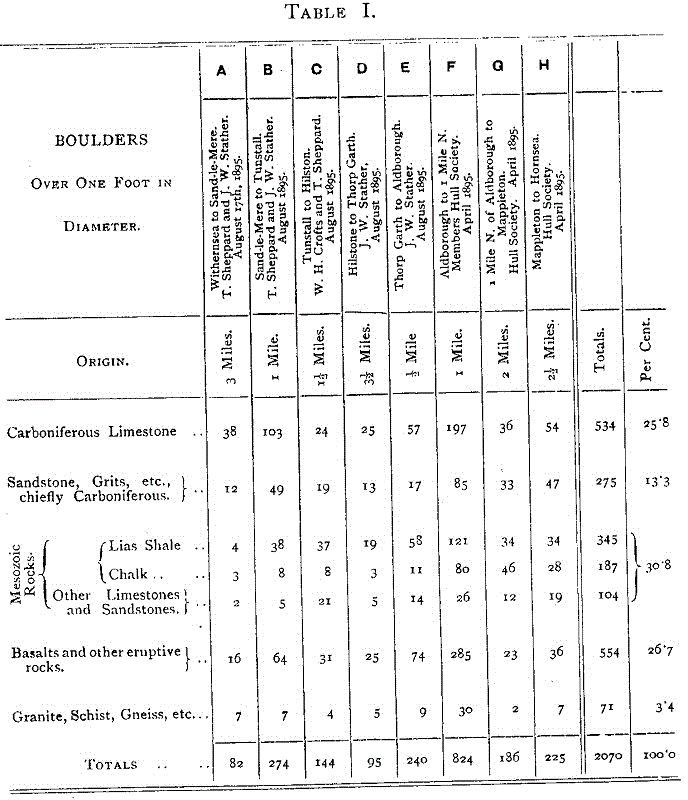
TRANSACTIONS
OF THE
HULL
GEOLOGICAL
SOCIETY
REPORT OF [THE EAST RIDING] BOULDER COMMITTEE.
BOULDERS NOTED ON THE HOLDERNESS COAST BETWEEN
WITHERNSEA AND HORNSEA, 1895.

Note 1 The above is a rough classification of 2070
boulders (above a foot in diameter), noted on the Holderness coast between
Withernsea and Hornsea, a distance of 14 miles, during the summer of 1895
Note 2 All the boulders tabulated in sections A, B, C,
D, E, G, H, in above table, were in
situ in the clay, or were close to the boulder clay cliff from whence
they were recently fallen. In section F, however, a large group of boulders
occurred at about 'half-tide,' and these are included in the Table.
Note 3. Table I. gives the
actual number of boulders noted in the different sections of coast. Table
II. gives the percentage of the different classes of the rocks.
Note 4. The largest boulder
seen was a block of Carboniferous Limestone on the beach near Mappleton,
85in × 31 in
x 30 in and
many others approaching this size.
A
block of garnetiferous schist was noted at base of cliff near Cowden, 22
in. x 30 in x 13 in.

REPORT OF BOULDER COMMITTEE.
Reported
by
Mr. T. SHEPPARD, HULL
BURSTWICK. Six miles north-east of Hull. A gravel-pit, underlying boulder clay, yielded the following varieties of boulders seldom exceeding a foot in diameter, and more or less water-worn :- Chalk and flint (Belemnites), Lias limestone and Marlstone (A. communis, Gryphcea), Old rhyolites, Carb. Limestone, Brockram, Quartz felsite (Armboth), Whin Sill, Rhomb porphyry, Red granite (Norwegian ?) Gneiss, Volcanic lava.
NOTE.---In the village of Burstwick are numerous
boulders forming curbs, door-steps, etc. Several of these exceed a foot in
diameter, and they are all well rounded. No doubt the greater part of them
are from the gravel-pit. Among them are the following :- Basalt, very
common, especially at the street corners; Carboniferous Limestone with
fossils, numerous; granites both pink and white varieties, frequently used
as doorsteps; Gneiss, one very large boulder a few yards from the village
'pub.' ; Quartzite, several on roadside leading to the church; Old rhyolite,
occasionally met with as curbs on roadside. A boulder of undoubted Norwegian
origin--augite-syenite--was found in a field near Burstwick, at a recent
excursion of the Hull Geological Society.
Reported by
Mr. J. W. STATHER, F.G.S., Hon. Sec. Hull Geol Soc.
MELTON. About six miles west of Hull and south of the
village of Melton, the bank of the Humber is formed for about a quarter of a
mile by a low cliff of boulder clay locally known as Redcliff. The clay is
full of boulders, including a large percentage of far-travelled rocks. In my
collection from this locality, Mr. Alfred Harker has recognised two
Norwegian types, viz. the Augite-syenite (Larvikite of Br6gger), and Rhomb
porphyry, neither of which have been observed so far west before. Along with
these we find Brockram from the Vale of Eden, as well as other rocks waiting
identification.
BESSINGBY. In July last I obtained the Rhomb porphyry
from a clay-pit at the top of Bessingby Road, about a mile and a half south
of Bridlington Quay.
Retorted by Mr.
J. F. ROBINSON.
SWINE. A small boulder of Rhomb porphyry embedded five
feet deep in boulder clay.
Reported by
Mr. F. F. WALTON, F.G.S.
HESSLE. Small boulder of Rhomb porphyry from boulder
clay overlying the gravel at Southfield.
[Note -This article has been scanned in from original printed format and then put through an OCR program by Mike Horne. The process may have introduced some new spelling errors to the texts. Some original misspellings have been corrected.]
Copyright Hull Geological Society 2020
